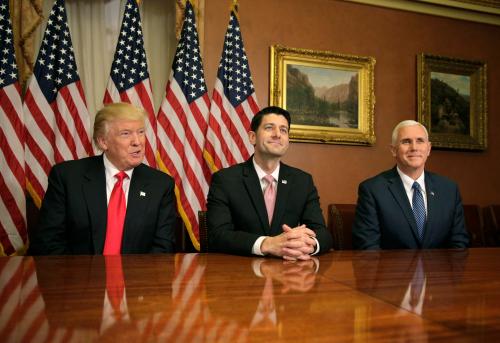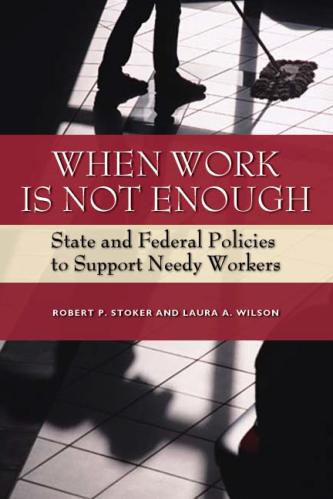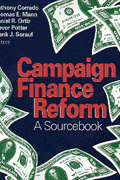This article originally appeared on Real Clear Markets on July 28, 2017.
The so-called “Big Six” of Republican policy makers has now laid out general guidelines for tax legislation. The group – including House Speaker Paul Ryan, Ways and Means Chairman Kevin Brady, Senate Majority Leader Mitch McConnell, Senate Finance Chairman Orrin Hatch, Treasury Secretary Steven Mnuchin and National Economic Council Director Gary Cohn – favors a long list of items – income tax rate cuts, more generous business deductions, changes to the taxation of foreign income, and so on.
This agreement might seem to make tax changes inevitable. President Trump has said that after health care, tax reform is going to be “so easy” and has promised “the biggest tax cut we’ve ever had” Paul Ryan has called Republican control of Congress and the Administration a “once-in-a-lifetime opportunity” to change tax policy.
But high hurdles stand in the way of significant tax changes. Tax reform means different things to different parts of the Republican Party and its constituencies, and procedural rules in the Senate will limit options. The most likely outcome is that, instead of sweeping tax reform, the Republicans will settle for a package of tax cuts without structural change.
Here are some of the issues and challenges Republicans face in passing tax legislation:
The first issue is whether to work on a bipartisan basis and use conventional legislative channels or to work on a partisan basis and use a process called “budget reconciliation.” The Big Six say they expect to use conventional legislation, which would require 60 votes in the Senate to prevent a filibuster. However, Republicans only have 52 votes and are unlikely to attract much Democratic support. So, to move forward, reform will likely require reconciliation procedures.
Reconciliation allows Congress to “fast track” bills that are consistent with a budget resolution. Reconciliation bills are not subject to filibuster in the Senate, and as a result can pass with 51 votes (or 50 plus the Vice President as a tiebreaker). Originally, reconciliation was designed to ease the passage of deficit-reduction bills, but beginning under President George W. Bush, Congress has used reconciliation on occasion to raise the deficit as well.
Still, reconciliation is not a free pass. To use it, Republicans first have to pass a budget resolution, which requires almost all of them to agree on spending levels. This will not be easy. In January, they passed a “shell” budget that left most spending programs as they were, so that they could pave the way for using the reconciliation process to repeal and replace Obamacare. Conservatives, members of the House Freedom Caucus in particular, went along with this approach because they expected the “repeal and replace” legislation to move quickly. Obviously, it has not. This time around, hardline conservatives oppose the House’s proposed budget and demand substantial cuts in mandatory spending, but these cuts are politically risky and others in the party oppose them.
Even if Republican leaders manage to pass a budget resolution and thus obtain reconciliation protection, they must decide whether to go for revenue-neutral tax reform or tax cuts. Revenue-neutral tax reform will be hard to enact, since it requires tax increases on some people or businesses in order to finance tax cuts for others. No political party wants to take sole responsibility for the tax increases and, historically, few have done so by themselves.
The most likely outcome is that, instead of sweeping tax reform, the Republicans will settle for a package of tax cuts without structural change.
But tax cuts also face a number of hurdles. A provision called the Byrd rule disallows proposals under reconciliation that raise the deficit in any year after the end of the budget window, which is currently set at 10 years. That rules out long-term tax cuts unless they are fully paid for with spending cuts.
And the Byrd rule may preclude many temporary cuts too. Recently, the Joint Committee on Taxation estimated that even a three-year cut to corporate tax rates would trigger the Byrd rule because firms would repatriate more foreign-held assets while taxes were temporarily low. This would reduce their future repatriations and hence future revenues.
A second limitation on tax cuts is that Senate rules make reconciliation legislation that raises the deficit in the first five or first 10 years subject to a 60-vote point of order. So, the ability to avoid the 60-vote requirement is limited, even under reconciliation.
After all that, Republicans would still need to agree on what goes into the final tax package. This may prove difficult for two reasons. First, the statement by the Big Six produced a very ambitious wish list of reforms. The hard work of ironing out the details of an agreement and coming up with legislative language has yet to be done.
Second, Treasury Secretary Steven Mnuchin famously promised that enacting tax reform would mean “no absolute tax cut” for the wealthy. This will prove a difficult criterion to meet, as the major provisions under consideration constitute a frontal assault on the most progressive features of the tax system. Leading Republican proposals— including cutting the pass-through business and corporate tax rate, cutting the top personal income tax rate, and eliminating the alternative minimum tax and estate tax— would all dramatically cut taxes for high-income households. The Tax Policy Center estimates that Trump’s recent proposals— even including the “pay-fors” that could be inferred from the proposals – would give about half of all of the benefits to the top 1 percent and would raise their average after-tax income by 11.5 percent.
The bottom line is that, to bring about major tax changes, Republicans either will have to attract Democratic support, raise taxes on some people, cut spending substantially, resort to major budget gimmicks, or take a machete to Congressional budget rules. It seems likely that major tax changes will remain elusive.







Commentary
Op-edCan Republicans thread the needle on tax policy?
July 28, 2017